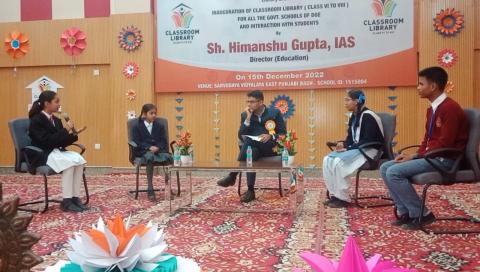
In Delhi Government Schools, promoting reading through classroom libraries
Recently, the Directorate of Education, GNCT of Delhi has launched the classroom library project for its schools. In terms of improving children's access to print-rich environments, this is a revolutionary step. Primary classes in DOE already have classroom libraries. Several pieces of research prove that the exposure of children to a print-rich environment makes a solid foundation for academic growth. When most of our children come from disadvantaged backgrounds, this becomes even more crucial.
If we look at the data available on the UDISE, the initiative to have a classroom library becomes unique. Approximately 13% of schools in India do not have a library. In absolute numbers, it is around 2 lakh schools. In 28% of government schools, libraries do not have books. Don’t be surprised to know that in Private Schools this figure touches 33%. This shows the dilapidated state of affairs. In this context, the idea of a classroom library in the DOE schools makes it the apex system of schooling in the country.
The value of a classroom library is indisputable. It is, however, teachers who are responsible for creating a conducive learning environment in the classroom. Research suggests that when students see their teachers read, they read. Do we have a culture of reading among our teachers?
Sharing an anecdote!
One of my teacher friends once told me that he simply copied and pasted the content into the Annual Confidential Report (ACR) with the help of school IT staff. In the ACR, there is a column that asks about the books you read during the academic year. Copy-pasting mechanisms have resulted in a teacher reading the same book for the past 10 years. In other words, he/she is not reading any book. The excuse is perennial…There is no time for reading books.
I remember a valuable suggestion a professor shared with me. If one or two people don't read, it's an individual problem, but if a large number of people don't read, it's a systemic problem. We must acknowledge that in the system there is no incentive for reading. Reading will continue to be ignored until we establish that a teacher cannot function effectively without reading. It has to be made part of our pedagogic practices. The reason behind the apathy towards reading was explored deeply in Krishna Kumar’s book-Padhna Jada Sochna.
We are at an interesting juncture in the history of educational reforms in Delhi. Here, there is a will to solve the problem. I feel that this is the outcome of the will that we have a classroom library, and we have systemic support for the reading campaigns such as ‘Read With a Teacher’, ‘Read with Students’ and ‘Literaria’. The Library branch of the DOE is making a tremendous effort to promote the culture of reading. The moderate book grant for the teachers and officials is a praiseworthy initiative of the library branch. Let's come together to discuss how we can bring this culture of reading to all of our schools. We cannot take it to students without taking it to teachers. The bigger question is how? How can we make reading a part of our pedagogic practices? Well, bigger questions need larger collaboration. We have to come together to think through this issue. Can we think of a Reading Conference?
Wait…I will come with the details of the Reading Conference.
- Log in to post comments
